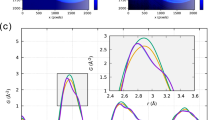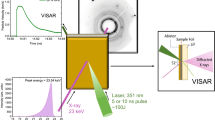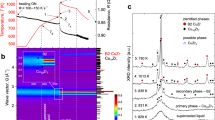Abstract
Differential scanning calorimetry (DSC) is widely used to study the stability of amorphous solids, characterizing the kinetics of crystallization close to the glass-transition temperature Tg. We apply ultrafast DSC to the phase-change material Ge2Sb2Te5 (GST) and show that if the range of heating rates is extended to more than 104 K s−1, the analysis can cover a wider temperature range, up to the point where the crystal growth rate approaches its maximum. The growth rates that can be characterized are some four orders of magnitude higher than in conventional DSC, reaching values relevant for the application of GST as a data-storage medium. The kinetic coefficient for crystal growth has a strongly non-Arrhenius temperature dependence, revealing that supercooled liquid GST has a high fragility. Near Tg there is evidence for decoupling of the crystal-growth kinetics from viscous flow, matching the behaviour for a fragile liquid suggested by studies on oxide and organic systems.
This is a preview of subscription content, access via your institution
Access options
Subscribe to this journal
Receive 12 print issues and online access
$259.00 per year
only $21.58 per issue
Buy this article
- Purchase on Springer Link
- Instant access to full article PDF
Prices may be subject to local taxes which are calculated during checkout





Similar content being viewed by others
References
Wuttig, M. & Yamada, N. Phase-change materials for rewriteable data storage. Nature Mater. 6, 824–832 (2007).
Redaelli, A., Pirovano, A., Benvenuti, A. & Lacaita, A. L. Threshold switching and phase transition numerical models for phase change memory simulations. J. Appl. Phys. 103, 111101 (2008).
Kalb, J. A., Wen, C. Y., Spaepen, F., Dieker, H. & Wuttig, M. Crystal morphology and nucleation in thin films of amorphous Te alloys used for phase change recording. J. Appl. Phys. 98, 054902 (2005).
Akola, J. & Jones, R. O. Structural phase transition on the nanoscale: The crucial pattern in the phase-change materials Ge2Sb2Te5 and GeTe. Phys. Rev. B 76, 235201 (2007).
Hegedüs, J. & Elliott, S. R. Microscopic origin of the fast crystallization ability of Ge–Sb–Te phase-change memory materials. Nature Mater. 7, 399–405 (2008).
Angell, C. A. Formation of glasses from liquids and biopolymers. Science 267, 1924–1935 (1995).
Chebli, K., Saiter, J. M., Grenet, J., Hamou, A. & Saffarini, G. Strong-fragile glass forming liquid concept applied to GeTe chalcogenide glasses. Physica B 304, 228–236 (2001).
Kalb, J. A., Wuttig, M. & Spaepen, F. Calorimetric measurements of structural relaxation and glass transition temperatures in sputtered films of amorphous Te alloys used for phase change recording. J. Mater. Res. 22, 748–754 (2007).
Neumann, H., Herwig, F. & Hoyer, W. The short range order of liquid eutectic AIII-Te and AIV-Te alloys. J. Non-Cryst. Solids 205-207, 438–442 (1996).
Senkader, S. & Wright, C. D. Models for phase-change of Ge2Sb2Te5 in optical and electrical memory devices. J. Appl. Phys. 95, 504–511 (2004).
Ashkenazy, Y. & Averback, R. S. Kinetic stages in the crystallization of deeply undercooled body-centered-cubic and face-centered-cubic metals. Acta Mater. 58, 524–530 (2010).
Sun, Y., Xi, H., Chen, S., Ediger, M. D. & Yu, L. Crystallization near glass transition: Transition from diffusion-controlled to diffusionless crystal growth studied with seven polymorphs. J. Phys. Chem. B 112, 5594–5601 (2008).
Ediger, M. D., Harrowell, P. & Yu, L. Crystal growth kinetics exhibit a fragility-dependent decoupling from viscosity. J. Chem. Phys. 128, 034709 (2008).
Nascimento, M. L. F. & Zanotto, E. D. Does viscosity describe the kinetic barrier for crystal growth from the liquidus to the glass transition? J. Chem. Phys. 133, 174701 (2010).
Choi, Y., Jung, M. & Lee, Y. K. Effect of heating rate on the activation energy for crystallization of amorphous Ge2Sb2Te5 thin film. Electrochem. Solid State Lett. 12, F17–F19 (2009).
Kissinger, H. E. Reaction kinetics in differential thermal analysis. Anal. Chem. 29, 1702–1706 (1957).
Weidenhof, V, Friedrich, I., Ziegler, S. & Wuttig, M. Laser induced crystallization of amorphous Ge2Sb2Te5 films. J. Appl. Phys. 89, 3168–3176 (2001).
Zhuravlev, E. & Schick, C. Fast scanning power compensated differential scanning nano-calorimeter: 1. The device. Thermochim. Acta 505, 1–13 (2010).
Zhuravlev, E. & Schick, C. Fast scanning power compensated differential scanning nano-calorimeter: 2. Heat capacity. Thermochim. Acta 505, 14–21 (2010).
Chonde, M., Brindza, M. & Sadtchenko, V. Glass transition in pure and doped amorphous solid water: An ultrafast microcalorimetry study. J. Chem. Phys. 125, 094501 (2006).
Park, J., Kim, M. R., Choi, W. S., Seo, H. & Yeon, C. Characterization of amorphous phases of Ge2Sb2Te5 phase-change optical recording material on their crystallization behavior. Jpn. J. Appl. Phys. 38, 4775–4779 (1999).
Friedrich, I., Weidenhof, V., Njoroge, W., Franz, P. & Wuttig, M. Structural transformations of Ge2Sb2Te5 films studied by electrical resistance measurements. J. Appl. Phys. 87, 4130–4134 (2000).
Kelton, K. F. Analysis of crystallization kinetics. Mater. Sci. Eng. A 226–228, 142–150 (1997).
Cohen, M. H. & Grest, G. S. Liquid-glass transition, a free-volume approach. Phys. Rev. B 20, 1077–1098 (1979).
Thompson, C. V. & Spaepen, F. On the approximation of the free energy change on crystallization. Acta Metall. 27, 1855–1859 (1979).
Battezzati, L. & Greer, A. L. Thermodynamics of Te80Ge20−xPbx glass-forming alloys. J. Mater. Res. 3, 570–575 (1988).
Morales-Sanchez, E., Prokhorov, E. F., Mendoza-Galvan, A. & Gonzalez-Hernandez, J. Determination of the glass transition and nucleation temperatures in Ge2Sb2Te5 sputtered films. J. Appl. Phys. 91, 697–702 (2002).
Kalb, J., Spaepen, F. & Wuttig, M. Atomic force microscopy measurements of crystal nucleation and growth rates in thin films of amorphous Te alloys. Appl. Phys. Lett. 84, 5240–5242 (2004).
Wang, Q. et al. Diffusion-controlled crystal growth in deeply undercooled Zr50Cu50 melt on approaching the glass transition. Phys. Rev. B 83, 014202 (2011).
Gille, T., De Meyer, K. & Wouters, D. J. Amorphous–crystalline phase transitions in chalcogenide materials for memory applications. Phase Transit. 81, 773–790 (2008).
Greaves, G. N., Greer, A. L., Lakes, R. S. & Rouxel, T. Poisson’s ratio and modern materials. Nature Mater. 10, 823–837 (2011).
Acknowledgements
J.O., A.L.G., B.G. and D.W.H. acknowledge support from the Engineering and Physical Sciences Research Council (EPSRC, UK), B.G. and D.W.H. in part through the EPSRC Centre for Innovative Manufacturing in Photonics. G. N. Greaves, K. F. Kelton and S. R. Elliott are thanked for helpful discussions.
Author information
Authors and Affiliations
Contributions
J.O. and C.E.S. performed the calorimetry. B.G. and D.W.H. deposited the GST films. A.L.G. led the work and wrote the paper. All authors contributed to interpretation of the results.
Corresponding author
Ethics declarations
Competing interests
The authors declare no competing financial interests.
Supplementary information
Supplementary Information
Supplementary Information (PDF 1042 kb)
Rights and permissions
About this article
Cite this article
Orava, J., Greer, A., Gholipour, B. et al. Characterization of supercooled liquid Ge2Sb2Te5 and its crystallization by ultrafast-heating calorimetry. Nature Mater 11, 279–283 (2012). https://doi.org/10.1038/nmat3275
Received:
Accepted:
Published:
Issue Date:
DOI: https://doi.org/10.1038/nmat3275
This article is cited by
-
Device-scale atomistic modelling of phase-change memory materials
Nature Electronics (2023)
-
Programmable nanophotonic planar resonator filter-absorber based on phase-change InSbTe
Scientific Reports (2023)
-
Study on the Crystallization Behavior of Sb2Te Thin Films for Phase-Change Memory Applications
Journal of Electronic Materials (2023)
-
Fast differential scanning calorimetry to mimic additive manufacturing processing: specific heat capacity analysis of aluminium alloys
Journal of Thermal Analysis and Calorimetry (2023)
-
Highly tunable β-relaxation enables the tailoring of crystallization in phase-change materials
Nature Communications (2022)



